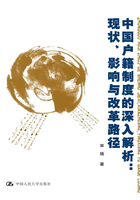
3.5 讨论和结语
概括来说,研究表明,农村户籍的移民在中国城市高薪国企中面临工资歧视。国有部门相比私营部门会更多地歧视农村户籍劳动者,其中部分原因是受到政府的保护,不受市场竞争压力的影响。此外,分位数回归和分解的结果告诉我们,基于户口的工资歧视主要是针对中高收入劳动者,特别是在国有部门。而且,就歧视的程度而言,国有部门中女性劳动者遭受的歧视比男性劳动者更多。
回到本章最开始提出的问题:为什么一些农村户口工人选择在农村从事低工资的工作,而不是在城市从事工资更高的工作?这个问题的另一面是为什么一些农村户口持有者选择在城市工作,尽管受到歧视。毫无疑问,原因不仅仅是工资歧视,但工资歧视确实是一个重要的解释。
不同的力量给予市场相反的作用力,使得内部均衡能够实现。在这个稳定的均衡中,有些人选择留在农村,而其他人选择迁移。中国城市的平均工资水平较高,这鼓励一些农村户籍人口迁移到城市。但是,并不是所有的农村户籍人口都能迁移到城市,因为户籍制度在中国劳动力市场上有两种作用,这限制了农村到城市的迁移。一方面,中国城市高薪国企对农村户口持有者有工资歧视,这降低了与迁移到城市相关的预期收益。另一方面,农村户口持有者在城市居住时必须承担较高的生活成本,但却无法和城镇户口居民一样享受各种政府项目和公共服务(Song,2014;Chen and Yang,2010)。这两方面共同作用使得一些农村户口持有者选择留在农村,接受较低的工资。
在一篇工作论文中,Fields和Song(2013)建立了一个理论模型,包含了上面提到的户籍制度的两种作用,并在理论上证明了内部均衡。本章从劳动力市场歧视的角度,为这一解释提供了坚实的经验证据。
由于中国政府仍然对国有部门的薪酬有一定影响,本章的一个重要政策意义在于减少国有部门对农村户口持有者特别是对中高收入女性劳动者的工资歧视。减少劳动力市场中高薪国有部门对农村户口持有者的歧视,将促进中国城市化进程的发展,从而推动中国经济的长期增长。
附录1 Tunali的双重选择模型
按照方程(3-1)~(3-8)的符号,令S为虚拟变量,当S*i≥0时,S=1,否则S=0。类似地,令U为虚拟变量,当U*i≥0时,U=1,否则U=0。S和U分别表示个人是否在国有部门工作和是否有城镇户口。在估计两个选择方程的双变量概率模型后,我们可以得到以下选择性修正项。


在第二步,我们估计如下所述的两个所有权部门的城镇户口持有者和农村户口持有者的四个增加工资方程。

基于从增加工资的回归方程(A3-1)~(A3-4)中得到的估计,我们可以分解出国有部门和私营部门中的城镇户口持有者与农村户口持有者的平均工资差额。方程(A3-5)和方程(A3-6)分别提供了国有部门和私营部门工资分解的公式( )。
)。

附录2 变量定义
此部分介绍本章中使用的每个变量的度量方式。自变量以原始形式而不是对数形式进入回归方程。
每小时收入:将每月收入除以一个月内工作的总时数。
受教育年限:接受了多少年正规教育。
工作年限:年龄减去受教育年限再减去六年计算出的潜在工作年数。
社会资本:以过去的中国春节中个人发出的问候短信数量来衡量。
公司任职年限:个人在当前组织工作的年数。
从父母处获得收入:个人在过去十二个月内从父母那里收到的货币总额。
政府推荐:一个虚拟变量,表示个人是否被政府推荐获得这项工作。
孩子数量:这个信息是从“你有过几个孩子”的问题中得到的。
健康状况:一个取值范围为1到5的序数变量。
身高:以厘米为单位。
体重:以千克为单位。
学习成绩:这个信息是从“你上一次离开学校之前的课堂表现如何”的问题中得到的,它是一个取值范围为1(很好)到5(非常差)的序数变量。
性别:一个虚拟变量,男性为1,女性为0。
婚姻状况:一个虚拟变量,已婚为1,未婚为0。
职业培训:一个虚拟变量,接受过职业培训为1,没有接受过职业培训为0。
企业规模:这个信息是从“你的工作单位中有多少名员工(包括你自己)”的问题中获得的。
职业:这包含25个职业虚拟变量。
行业:这包含29个行业虚拟变量。
地区变量:这包含8个省份虚拟变量。
参考文献
Aigner,D.,Cain,G.,1977.Statistical theories of discrimination.Industrial &;Labor Relations Review,30(2):175-187.
Arrow,K.,1973. The theory of discrimination//Ashenfelter,O.,Rees,A..Discrimination in labor markets.Princeton University Press: 3-33.
Becker,G.S.,1971.The economics of discrimination.2nd ed.Chicago:University of Chicago.
Cai,F.,2011.Hukou system reform and unification of rural-urban social welfare.China &;World Economy,19(3):33-48.
Chan,K.W.,2010.The household registration system and migrant labor in China:notes on a debate.Population and Development Review,36(2):357-364.
Chan,K.W.,Buckingham,W.,2008.Is China abolishing the hukou system?.China Quarterly,195:582-606.
Chau,N., Kanbur, R.,Qin,Y.,2012. Do public work schemes deter or encourage outmigration? Empirical evidence from China. CEPR Discussion Paper 8778.
Chen,Y., Hoy,C.,2011. Explaining migrants' economic vulnerability in urban China.Asian Population Studies,7(2):123-136.
Chen,G.,Yang,J.,2010.Access to compulsory education by rural migrants' children in urban China:a case study from nine cities.Educational Research,1(10):512-519.
Chen,Y.,Démurger,S.,Fournier,M.,2005.Earnings differentials and ownership structure in Chinese enterprises.Economic Development and Cultural Change,53(4):933-958.
Cotton,J.,1988.On the decomposition of wage differentials.Review of Economics and Statistics,70(2):236-243.
Demurger,S.,Li,S.,Yang,J.,2012.Earnings differentials between the public and private sectors in China:exploring changes for urban local residents in the 2000s.China Economic Review,23:138-153.
Deng,Q.,2007.Earnings differential between urban residents and rural migrants:evidence from Oaxaca-Blinder and quantile regression decompositions.Chinese Journal of Population Science,2:8-16(in Chinese).
Dong,X.,Xu,L.,2009.Labor restructuring in China:toward a functioning labor market.Journal of Comparative Economics,37(2):287-305.
Doornik,J.A.,Hansen,H.,2008.An omnibus test for univariate and multivariate normality.Oxford Bulletin of Economics and Statistics,70:927-939.
Dulleck,U.,Fooken,J.,He,Y.,2012.Institutional and individual labor market discrimination based on hukou status:an artefactual field experiment.Unpublished Results.
Fields,G.S.,Song,Y.,2013. A theoretical model of the Chinese labor market.IZA Discussion Paper Series,No.7278.
Gagnon,J.,Xenogiani,T.,Xing,C.,2011.Are all migrants really worse off in urban labour markets:new empirical evidence from China.IZA Discussion Paper,No.6268.
Giulietti,C.,Ning,G.,Zimmermann,K.F.,2012.Self-employment of rural-to-urban migrants in China.International Journal of Manpower,33(1):96-117.
Gravemeyer,S.,Gries,T.,Xue,J.,2011.Income determination and income discrimination in Shenzhen.Urban Studies,48(7):1457-1475.
Heckman,J.J.,1979.Sample selection bias as a specification error.Econometrica,47(1):153-161.
Knight,J.,Deng,Q.,Li,S.,2011.The puzzle of migrant labor shortage and rural labor surplus in China.China Economic Review,22(4):585-600.
Koenker,R.,Basset,G.,1978.Regression quantiles.Econometrica,46:33-50.
Lee,L.,2012.Decomposing wage differentials between migrant workers and urban workers in urban China's labor markets.China Economic Review,23(2):461-470.
Liu,P.,Meng,X.,Zhang,J.,2000.Sectoral gender wage differentials and discrimination in the transitional Chinese economy.Journal of Population Economics,13:331-352.
Melly,B.,2005.Public-private sector wage differentials in Germany:evidence from quantile regression.Empirical Economics,30(2):505-520.
Meng,X.,2012.Labor market outcomes and reforms in China.The Journal of Economic Perspectives,26(4):75-101.
Mincer,J.,1974.Schooling,experience,and earnings.New York:National Bureau of Economic Research.
Mueller,R.,1998.Public-private sector wage differentials in Canada:evidence from quantile regressions.Economics Letters,60:229-235.
Oaxaca,R.,Ransom,R.,1994.On discrimination and the decomposition of wage differentials.Journal of Econometrics,61:5-21.
Oaxaca,R.,2007.The challenge of measuring labor market discrimination against women.Swedish Economic Policy Review,14:199-231.
Powers,D.A.,Yoshioka,H.,Yun,M.S.,2011.Mvdcmp:multivariate decomposition for nonlinear response models.The Stata Journal,11(4):556-576.
Rabe,B.,2011.Dual-earner migration:earnings gains,employment and self-selection.Journal of Population Economics,24(2):477-497.
Reimers,C.W.,1983.Labor market discrimination against Hispanic and Black men.Review of Economics and Statistics,65:570-579.
Song,Y.,2014.What should economists know about the current Chinese hukou system?. China Economic Review,29:200-212.
Song,Y.,2012.Poverty reduction in China:the contribution of popularizing primary education.China &;World Economy,20(1):105-122.
Song,J.,Li,S.,2010.Ownership and earnings inequality in urban China.Frontiers of Economics in China,5(4):582-603.
Tunali,I.,1986.A general structure for models of double-selection and an application to a joint migration/earnings process with remigration.Research in Labor Economics,8:235-282.
Wang,M.,2005.Urban labor market discrimination against migrants.Social Sciences in China,5:36-46(in Chinese).
Zhang,J.,Zhao,Z.,2011.Social-family network and self-employment:evidence from temporary rural-urban migrants in China.IZA Discussion Paper,No.5446.